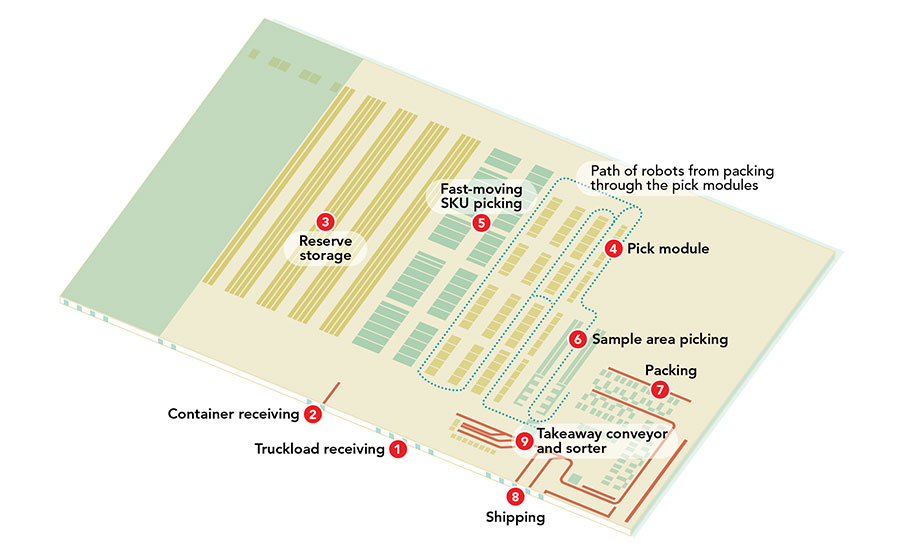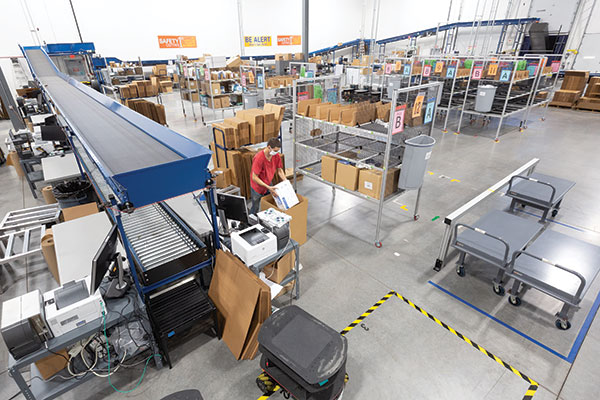NorthShore’s unique order and product profiles required an equally unique solution. In this case, autonomous mobile robots (AMRs) transport carts large enough to handle full carton picks.
You can read the full feature article on NorthShore Care Supply AMRs
Receiving
About half of incoming product is received on pallets (1) from U.S. manufacturers. The other half is floor loaded in containers (2) shipped from Europe and Asia. At receiving, palletized product is unloaded by lift trucks. Cartons are manually unloaded onto telescoping conveyor and palletized in the receiving area. In both instances, the warehouse management system (WMS) generates license plate bar code labels for directed putaway.
Putaway
Most newly received product will be stored in double deep pallet rack in the reserve storage area (3). Lift truck operators on standup reach trucks are system directed to a storage location. The pallet location and pallet are scanned to confirm putaway.
Replenishment
NorthShore Care Supply’s pick module features floor-mounted pallet flow rack (4), especially for fast-moving A and B items (5), as well as some shelving and case flow rack in the sample storage area (6). As order selectors fulfill orders they also create a list of items that need to be replenished. When an associate notifies the warehouse management system (WMS) that they are available for a replenishment task, the system directs them to a retrieval location and then to a putaway location.
Picking
Orders are dropped from the warehouse management system to the warehouse control system, which creates tasks for the autonomous mobile robots. The WCS groups orders by travel time and pick density and dispatches the robots. An available robot picks up a cart and travels toward its first pick location; at the same time, the voice system directs the nearest available order selector to the pick location. The order selector picks a carton to one of the pick locations and validates the pick with a ring scanner. Once all of the picks in an area are complete, the robot indexes to the next location. On light days, the order selector may walk with the robot. On busy days, order selectors will remain in their area.
Free samples are central to NorthShore Care Supply’s marketing program. Once the picks from the pick modules are complete, the robot travels to an area where sample products are stored to complete the orders on the cart.
Pack and ship
The packing area (7) is located near the shipping dock (8), which is serviced by motor-driven roller conveyor and extendable conveyor, which reaches into outbound parcel trailers. The area also features an overhead trash conveyor. Once all of the picks for a group of orders is complete, the WCS looks at which pack stations only have one cart and directs the robot to that location. The idea is to balance the workload at the pack stations. The WMS uses cartonization to execute the packing process. Labels are printed and applied to the cartons, which are then pushed onto the takeaway conveyor (9). The cartons pass through a scan and weigh station. Cartons that are out of tolerance are diverted to an inspection station and then to an automatic print-and-apply station. Cartons that pass the weight and scan audit are conveyed to shipping and diverted to the right dock door based on the parcel carrier.

System suppliers
- System design & integration, voice recognition, warehouse control system, and print & apply: The Numina Group
- Robotics: Waypoint Robotics
- Motor driven roller conveyor: TGW
- Extendable conveyor: Caljan
- WMS: NorthShore Care Supply
- ERP: Syspro supported by BT Partners
- Mobile computing & bar code scanning: Zebra Technologies
- Pallet rack: Ridg-U-Rak
- Pallet flow and carton flow rack: Mallard Manufacturing
- Shelving: Western Pacific Storage Solutions
- Lift trucks: Toyota Material Handling
About the Author
Follow Robotics 24/7 on Linkedin
About the Author
Follow Robotics 24/7 on Linkedin
Article topics
Email Sign Up



















